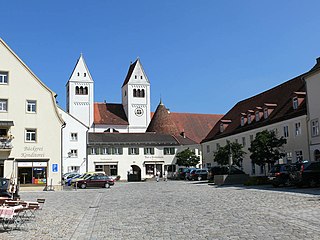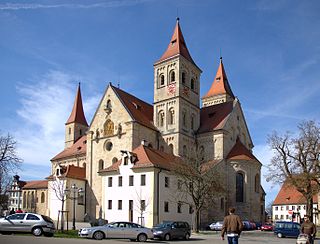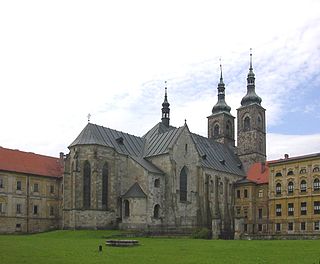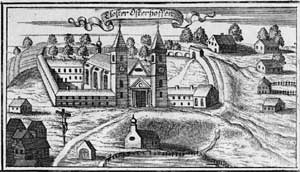
Steinfeld Abbey (Kloster Steinfeld) is a former Premonstratensian monastery, now a Salvatorian convent, with an important basilica, in Steinfeld in Kall, North Rhine-Westphalia, Germany.

Steinfeld Abbey (Kloster Steinfeld) is a former Premonstratensian monastery, now a Salvatorian convent, with an important basilica, in Steinfeld in Kall, North Rhine-Westphalia, Germany.
The origins of the site go back to about 920. The first monastic settlement at Steinfeld took place in about 1070, and the Premonstratensians settled here in 1130. It became an important monastery in the German Empire, and established a number of daughter houses across Europe, including Strahov Abbey in Prague. It was raised to the status of an abbey in 1184.
In 1802, Steinfeld Abbey was secularised. The basilica was put to use as a parish church, while the conventual buildings were used for a number of secular purposes until 1923, when the Salvatorians acquired them.

The basilica, formerly the abbey church, was built between 1142 and 1150 by the Premonstratensians as one of the earliest vaulted churches in Germany. The present structure includes features from a number of periods and styles, from the original Romanesque style through Gothic, Renaissance and Baroque up to modern stainless steel elements.
The church received the status of a papal basilica minor in 1960. It comprises altogether eight bays and six chapels, including Saint Stephen's Chapel and Saint Ursula's Chapel.

The basilica contains the tomb of Hermann Joseph of Steinfeld, a popular Premonstratensian saint, situated in the middle of the church and covered with a slab and a recumbent figure of alabaster, carved in 1732. This has become a pilgrimage destination. By custom apples are left here, in reference to a legend that Hermann once offered an apple to the Christ Child in the arms of the Madonna in the church of St. Maria im Kapitol at Cologne - who took it.
The basilica also contains the well-known König-Orgel, one of the most significant church organs of the Rhineland Baroque period. It was built around 1600, with additions in 1680, 1727 and 1934. It was taken out of service in 1977. In 1981, the organ was thoroughly restored by the firm Josef Weimbs Orgelbau from Hellenthal. It is composed of 1,956 pipes and 35 registers; the original pipework is still largely intact.
The original Romanesque cloister was replaced between 1492 and 1517 by a Gothic one. After the dissolution in 1802 the stained glass windows, made between 1526 and 1557 by Gerhard Remisch, were sold by a local dealer to a compatriot in Norwich in England. Some panels found their way to village churches in East Anglia, but the majority reached Lord Brownlow's collection at Ashridge Park, from where they were purchased by the Victoria and Albert Museum. Two panels are now in Steinfeld again.
While at Ashridge the glass was catalogued by M. R. James, who identified it as originating from Steinfeld, on which he based the short story "The Treasure of Abbot Thomas".
The monastery complex now includes a gymnasium , "Hermann-Josef-Kolleg Steinfeld", established in 1924.
Steinfeld Abbey is the location of the M.R. James short ghost story The Treasure of Abbot Thomas from Ghost Stories of an Antiquary

Hermann Joseph, was a German Premonstratensian canon regular and mystic. Never formally canonized, in 1958 his status as a saint of the Roman Catholic Church was formally recognized by Pope Pius XII.

Ettal Abbey is a Benedictine monastery in the village of Ettal close to Oberammergau and Garmisch-Partenkirchen in Bavaria, Germany. With a community of more than 50 monks, with another five at Wechselburg, the Abbey is one of the largest Benedictine houses and is a major attraction for visitors.

Maria Laach Abbey is a Benedictine abbey situated on the southwestern shore of the Laacher See, near Andernach, in the Eifel region of the Rhineland-Palatinate in Germany. It is a member of the Beuronese Congregation within the Benedictine Confederation. The abbey was built in the 11th-12th centuries and was originally known as "Abtei Laach" until 1862 when the Jesuits added the name "Maria".

Niederaltaich Abbey is a house of the Benedictine Order founded in 741, situated in the village of Niederalteich on the Danube in Bavaria.

Eberbach Abbey is a former Cistercian monastery in Eltville in the Rheingau, Germany. On account of its Romanesque and early Gothic buildings it is considered one of the most significant architectural heritage sites in Hesse.

Steingaden Abbey was a Premonstratensian monastery in Steingaden in Bavaria, Germany.

Ellwangen Abbey was the earliest Benedictine monastery established in the Duchy of Swabia, at the present-day town of Ellwangen an der Jagst, Baden-Württemberg, about 100 km (60 mi) north-east of Stuttgart.

Schussenried Abbey is a former Catholic monastery in Bad Schussenried, Baden-Württemberg, Germany. It is famed for its Baroque library hall. The abbey was established in the 12th century by the Premonstratensian Order and made an Imperial Abbey in the 15th century. The monastery sustained immense damage in the Thirty Years' War. In the 18th century, the abbey began expansions in the Baroque style, but was unable to complete them. The abbey was secularized in 1803 and twice awarded during the process of German Mediatization, eventually becoming a possession of the Kingdom of Württemberg. Its second king, William I, opened a foundry on its grounds, which was followed by a nursing home. These ceased operation or moved out of the monastery in the 1990s.

St. Mang's Abbey, Füssen or Füssen Abbey was a Benedictine monastery in Füssen in Bavaria, Germany. It was founded in the 9th century, and dissolved during the post-Napoleonic secularisation of Bavaria.
Ursberg Abbey is a former Premonstratensian monastery, now a convent of the Franciscan St. Joseph's Congregation, situated in the small village of Ursberg in the district of Günzburg, Bavaria.

Strahov Monastery is a Premonstratensian abbey founded in 1143 by Jindřich Zdík, Bishop John of Prague, and Vladislaus II, Duke of Bohemia. It is located in Strahov, Prague, Czech Republic.
Roggenburg Abbey is a Premonstratensian canonry in Roggenburg near Neu-Ulm, Bavaria, in operation between 1126 and 1802, and again from its re-foundation in 1986. Since 1992 it has been a dependent priory of Windberg Abbey in Lower Bavaria. The monastery manages a training centre and a museum, and is widely known for its almost unchanged Baroque building and the organ concerts that are held in the church.

Windberg Abbey is a Premonstratensian monastery in Windberg in Lower Bavaria, Germany.

Rein Abbey is a Cistercian monastery in Rein near Gratwein, Styria, in Austria. Also known as the "Cradle of Styria", it is the oldest surviving Cistercian community in the world.

Teplá Abbey is a Premonstratensian abbey in the western part of Bohemia, included in the Archdiocese of Prague, Czech Republic. It was founded in 1193 by the blessed Hroznata, a Bohemian nobleman. The first monks came from the Abbey of Strahov in Prague.

Cappenberg Castle is a former Premonstratensian monastery, Cappenberg Abbey in Cappenberg, a part of Selm, North Rhine-Westphalia in Germany. It stands on an elevation, the Cappenberg, near Lünen and Werne, and is a vantage point offering views over the eastern Ruhrgebiet.

Osterhofen Abbey is a former monastery in Bavaria, Germany, It is located in the Altenmarkt section of Osterhofen, a town to the south of the Danube between Deggendorf and Vilshofen / Passau. It has its origins in a collegiate built in 1004–09. From 1128 to 1783 it was a Premonstratensian monastery. For a while it was then a convent. Today it contains a girls' secondary school. The former abbey church, a magnificent late baroque building erected in 1726–40, is now the Basilica of Saint Margaret.

Reformierte Kirche Rüti is an Evangelical Reformed church in the Swiss municipality of Rüti in the Canton of Zürich. It was built between 1214 and 1219 AD as the Romanesque style church of the then Premonstratensian Kloster Rüti, an abbey that was founded in 1206 by the House of Regensberg and suppressed in 1525 as part of the Reformation in Zürich.

Hamborn Abbey is a Premonstratensian monastery in the Alt-Hamborn district of Duisburg, Germany. The abbey is physically located in the diocese of Essen, although not formally part of it.